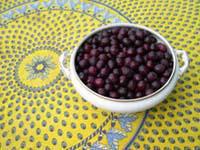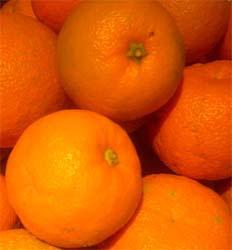Two recipes: Wild Damson Gin and Sloe Gin recipes
Posted by Fiona Nevile in Liqueurs | 716 comments
Wild damsons are a beautiful rich dark colour
Unlike sloes, wild damsons are hard to find. For every thirty wild plum trees there may be just one wild damson tree. When I spot wild damsons in the hedgerows, they are harvested into a special bag.
These, and the diminutive bullace, are the kings of hedgerow fruit. These tiny fruit make such an irresistible liqueur that overnight guests have actually turned down Danny’s famous cooked breakfast, and gone back to bed to sleep off the excesses of the night before.
Our damson and sloe gin is not the thick ultra sweet variety. We prefer the sugar to enhance rather than shield the flavour. Every three months or so it’s sampled and, if necessary, topped up with sugar. Usually no extra sugar is needed.
We try to keep our damson and sloe gin well away from the drinks tray! Each year we make a lot of fruit gin and vodka (more recipes to follow, in time). Sloe gin is the big craze at the moment around here, as sloes are more plentiful.
Here are our recipes for both. We are also starting experimenting with sloe gin see this post for details
Tips and tricks:
- Make more than you need the first year, so you can compare different vintages. This liqueur does improve over time.
- Some people drain the grog through muslin after a couple of months, to clarify the liqueur and bottle. We don’t bother as one old soak tipped that, once the gin is drunk, you can pour medium sherry on the fruit and start all over again! The latter is devilish and drinkable within three months. We have a recipe for this in our wine and gin section.
- Keep your fruit gin away from the light as this will maintain the colour. Unless it is in a dark green or brown bottle. Wrapping it in brown parcel paper will keep out the light.
- Make notes on a label of your fruit gin/vodka /sugar ratio and stick it onto the bottle(s) so that you have a record, if you make a particularly good batch. We note our responses as the grog matures. Yucky after sixth months can be to die for in a year (you will probably not remember without notes). Notes seem boring when you are making the grog but they are so worthwhile when you start again the next year. It won’t be long before you will get a feel of what works well for your taste (and the notes will come into their own).
- Adding almond essence to sloe gin lifts it from good to great. I haven’t tried this with the damson gin but return in a years’ time for our review.
- Don’t kill the liqueur with too much sugar at the start. Use the amount above to start your sloe or damson gin and then every couple of months take a tiny sip. At this time add more sugar if it is too sharp for your taste.
- Gin v Vodka? Vodka can be used as the spirit for these recipes. Although I’m a vodka drinker, we tend to stick to a gin base for our fruit liqueurs.
- A good damson gin can be made from ordinary damsons available in the shops. As they are bigger you would need to put them into a larger Le Parfait jar (I’d use a 2 litre size).
- People have been picking sloes from September 1st around here. Some people say that you shouldn’t pick sloes until after the first frost. This can be circumvented by putting your sloes in the freezer overnight. We don’t bother with either method and always have great results.
- This year we have made up a number of small (1lb honey jars) of sloe gin to give as Christmas presents.
| Wild Damson Gin and sloe gin Recipes |
- Wild damson gin:
- 1lb/454gm of washed wild damsons
- 6 ozs/168gm of white granulated sugar
- 75cl bottle of medium quality gin
- Sterilised 1 litre (at least) Le Parfait jar or wide necked bottle with stopper/cork
- Sloe Gin:
- 1lb/454gm of washed sloes
- 4 ozs/112gm of white granulated sugar
- 75cl bottle of medium quality gin
- Sterilised 1 litre (at least) Le Parfait jar or wide necked bottle
- 1-2 drops of almond essence
- Wild damson gin:
- Wash damsons well and discard any bad or bruised fruit. Prick fruit several times with a fork and place damsons in either a large
- Kilner/Le Parfait jar or a wide necked 1 litre bottle.
- Using a funnel, add the sugar and top up with gin to the rim.
- Shake every day until the sugar is dissolved and then store in a cool, dark place until you can resist it no longer (leave for at least three months, we usually let it mature for a year). If you are planning to drink this after 3 months, have a nip afetr a month, and top up with sugar to taste.
- Some people strain the grog (through muslin/jelly bag) after 3 months and bottle it, leaving it mature for six months. We strain and bottle after a year. Don’t leave the straining process any longer than a year; leaving the fruit in too long can spoil the liqueur, as we found to our cost one year.
- Sloe gin:
- Wash sloes well and discard any bruised or rotten fruit. Prick fruit several times with a fork and place sloes in either a large Kilner/Le Parfait jar or a wide necked 1 litre bottle. I put several sloes in my palm to prick them rather than picking them up one by one.
- Using a funnel, add the sugar and top up with gin to the rim. Always open sugar bags over the sink as sugar tends to get caught in the folds at the top of the bag.
- Add the almond essence.
- Shake every day until the sugar is dissolved and then store in a cool, dark place until you can resist it no longer (leave for at least three months, we usually let it mature for a year).
- Some people strain the grog (through muslin/jelly bag) after 3 months and bottle it, leaving it mature for six months. We strain and bottle after a year.
Leave a reply






A friend says that Aldi gin is good quality
Just reading some of the other comments about gin brands. When we make sloe gin we tend to use Shetland gin from Asda, it is alot smoother than the London gin varieties. I always found London gin is like drinking petrol fumes. Failing the Shetland gin we go for Plymouth gin (same principle, it’s smoother than London gin).
A couple of variations we do:
Plum Rum: same thing as the damson gin except using victoria plums from the garden and a golden rum instead of the gin.
Damson spiced Whisky: this one always goes down a treat on those cold winter nights around Christmas time. Same principle as the damson gin but instead use whisky (I prefer to use Whyte and McKay for this because it is cheap with vanilla undertones). Added to the damsons, one vanilla pod, a stick of cinamon, half teaspoon of grated nutmeg, half teaspoon of dry ginger powder and 3 cloves.
A one to avoid is blueberry tequila – we gave this a go last year after a glut of blueberries but it tastes like cough syrup.
Love the website, loads of interesting information and amusing reads. Have been making chutney, sloe gin, etc for a long time now, but love learning about other people’s hints and tips. Picked loads of ‘wild plums, bullaces’ call them what you will on Sunday and have made loads of chutney and am about to make some vodka/gin with the rest. Made some runner bean chutney for second year running it is amazing with cheese!! Old WASHED CLEAN tights are good for filtering!! Happy days, don’t you just love foraging…;
I have Damson trees growing wild and they are spreading growing through my Rhubarb which
i use to make rhubarb jam in Spring.Any ideas how can control them as they are tough to try and pull up.
In addition this year i am finding a lot of worms in the fruit any ideas what they are and how i can control them.
It seems to be OK in an open-top container. My first batch a couple of years ago (before I invested in Kilner jars) was made in a wide-necked decanter with a couple of layers of clingfilm; it was good enough to encourage me to make more the following year!
Hi I make large quantities of fruit liqueurs in those big plastic water cooler bottles and it’s fine. Also I notice Tesco are now selling brandy in plastic bottles so I’m sure you won’t have a problem. Good Luck.
Hi
Just made plum brandy and the plums were too big to fit through the top of my demi-johns. So it’s all ended up in a plastic bucket with a lid. Will it be ok in there? Does plastic affect the taste? Can you get large glass containers with wider openings?
“I comes in a nice bottle”
I don’t, but it does. Stupid keyboard…
WRT gin, I look for the cheapest with 40% alcohol, as most are 37.5%, which doesn’t sound like much, but it means you’re getting 2.5% more water!
Sainsbury’s sell Greenall’s gin, which is 40% and around £14/litre at the moment. I comes in a nice bottle, too.. 🙂